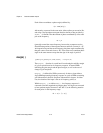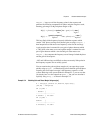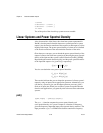
Chapter 5 Classical Feedback Analysis
© National Instruments Corporation 5-19 Xmath Control Design Module
By combining the information from the two plots, reflecting them across
the real axis to account for the negative frequency response and augmenting
them with a line closing the contour in the clockwise direction, you obtain
the sketch of the encirclement pattern shown in Figure 5-9. In this figure,
Nyquist contour is formed by drawing the system’s Nyquist plot for all
positive frequencies, reflecting it about the real axis to show plot for
negative frequencies, and completing the closed contour in a clockwise
direction.
Figure 5-9. Nyquist Contour Formed by Drawing the System’s Nyquist Plot
for All Positive Frequencies
Because your open-loop system has no unstable (right-half plane) poles,
the number of unstable closed-loop poles for a given gain K will be equal
to the number of times the contour encircles the (–1/K, 0) point.
Referring back to the Nyquist plots, you see that for K > 168
(or –1/K > –0.006), you have two encirclements of the (–1/K, 0) point,
and thus two unstable closed-loop poles. For gain values less than 167,
the closed-loop system is stable. You can verify this with a small
experiment, using a value of 169 for K:
sysu = 169*sys;
sysucl = feedback(sysu);
poles(sysucl)
ans (a column vector) =
Imaginary
Real


















